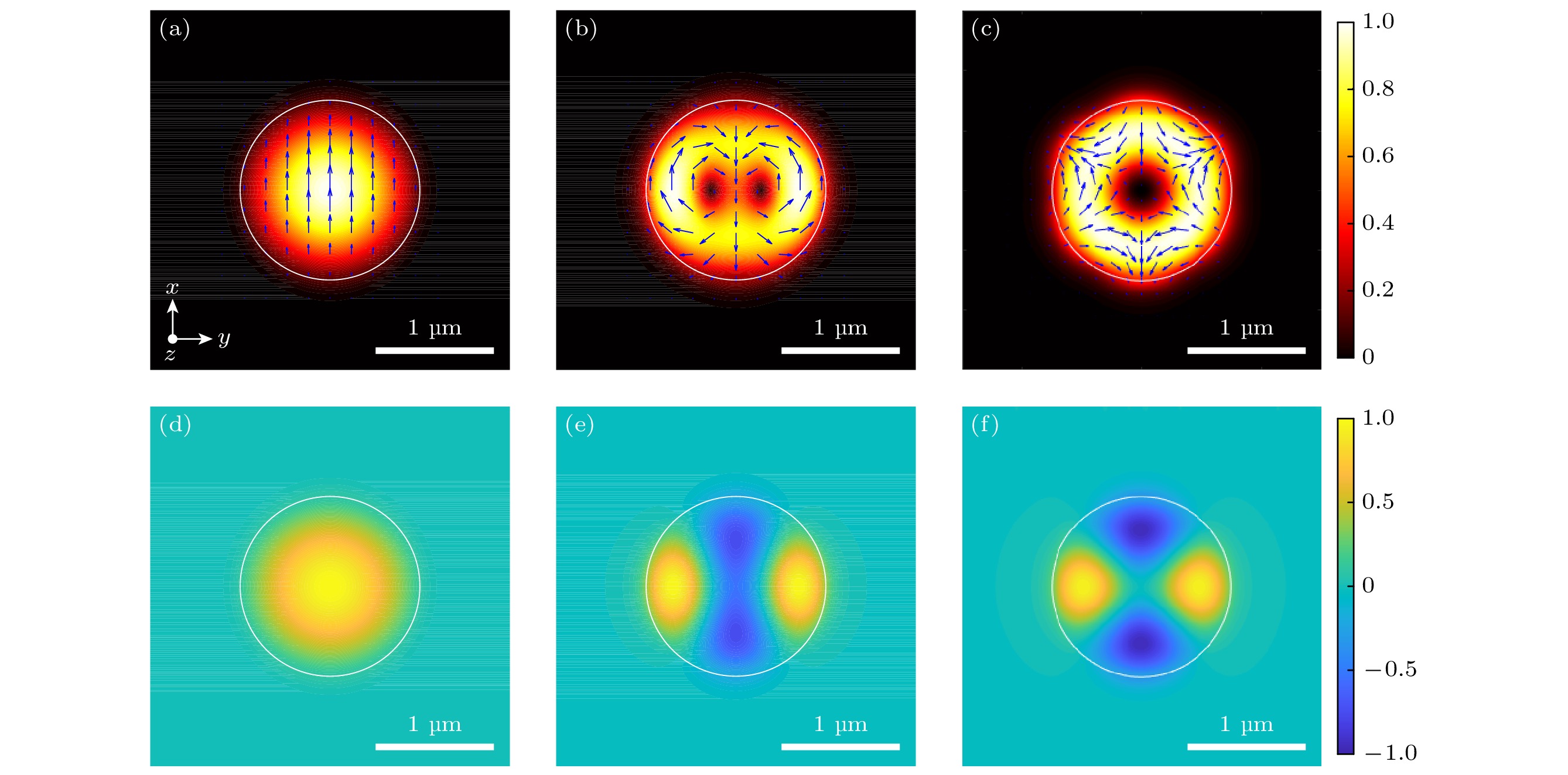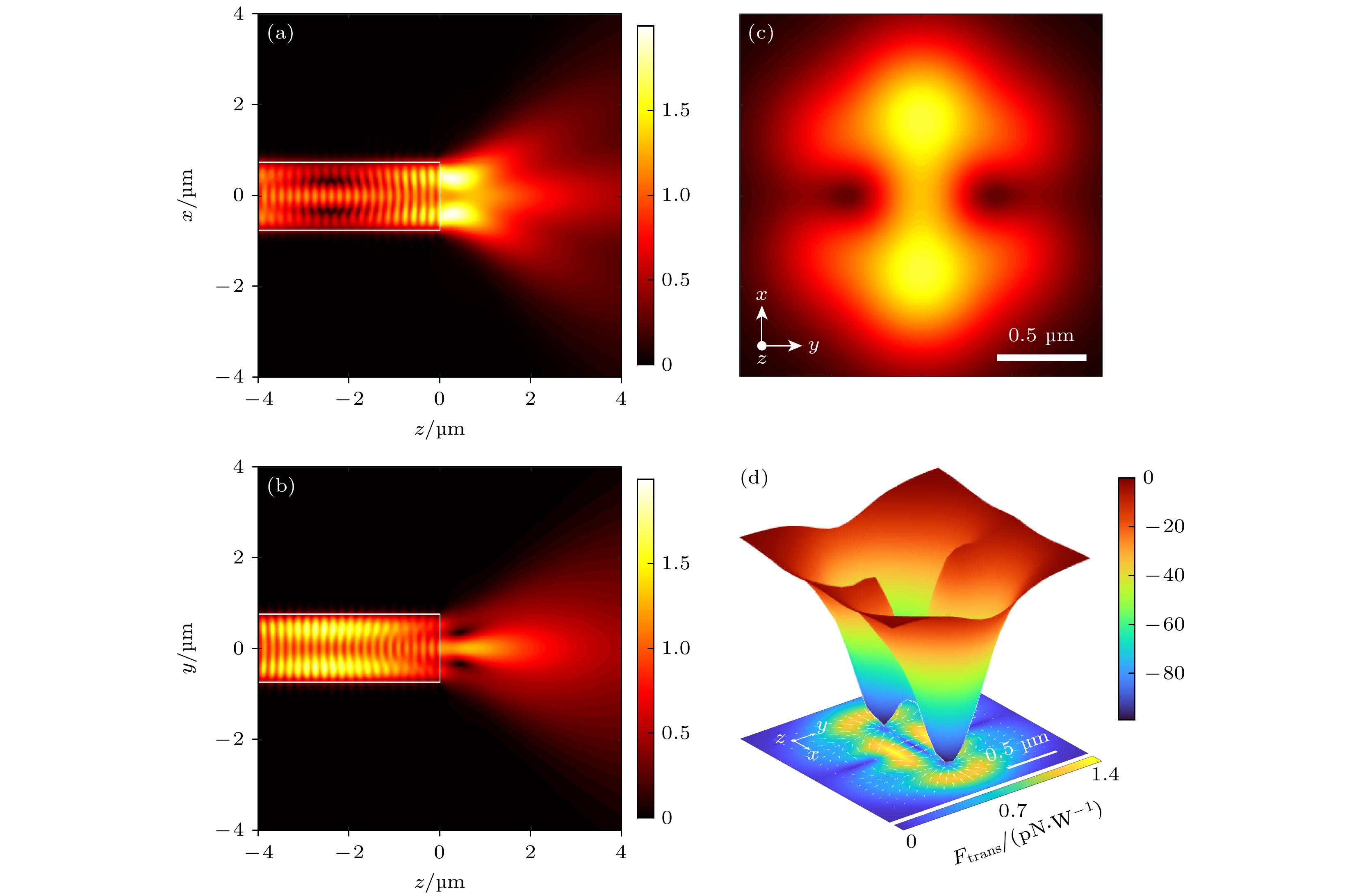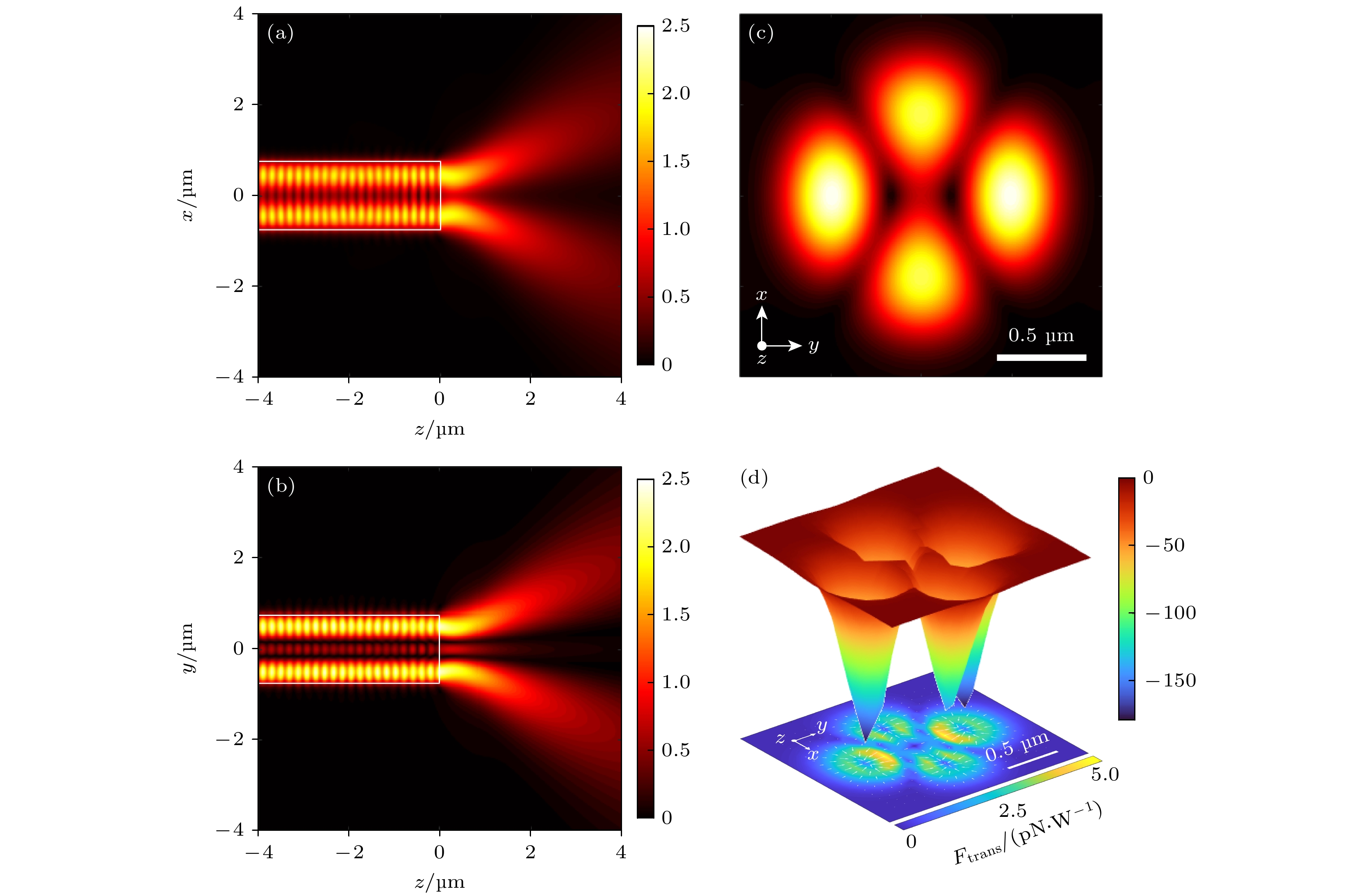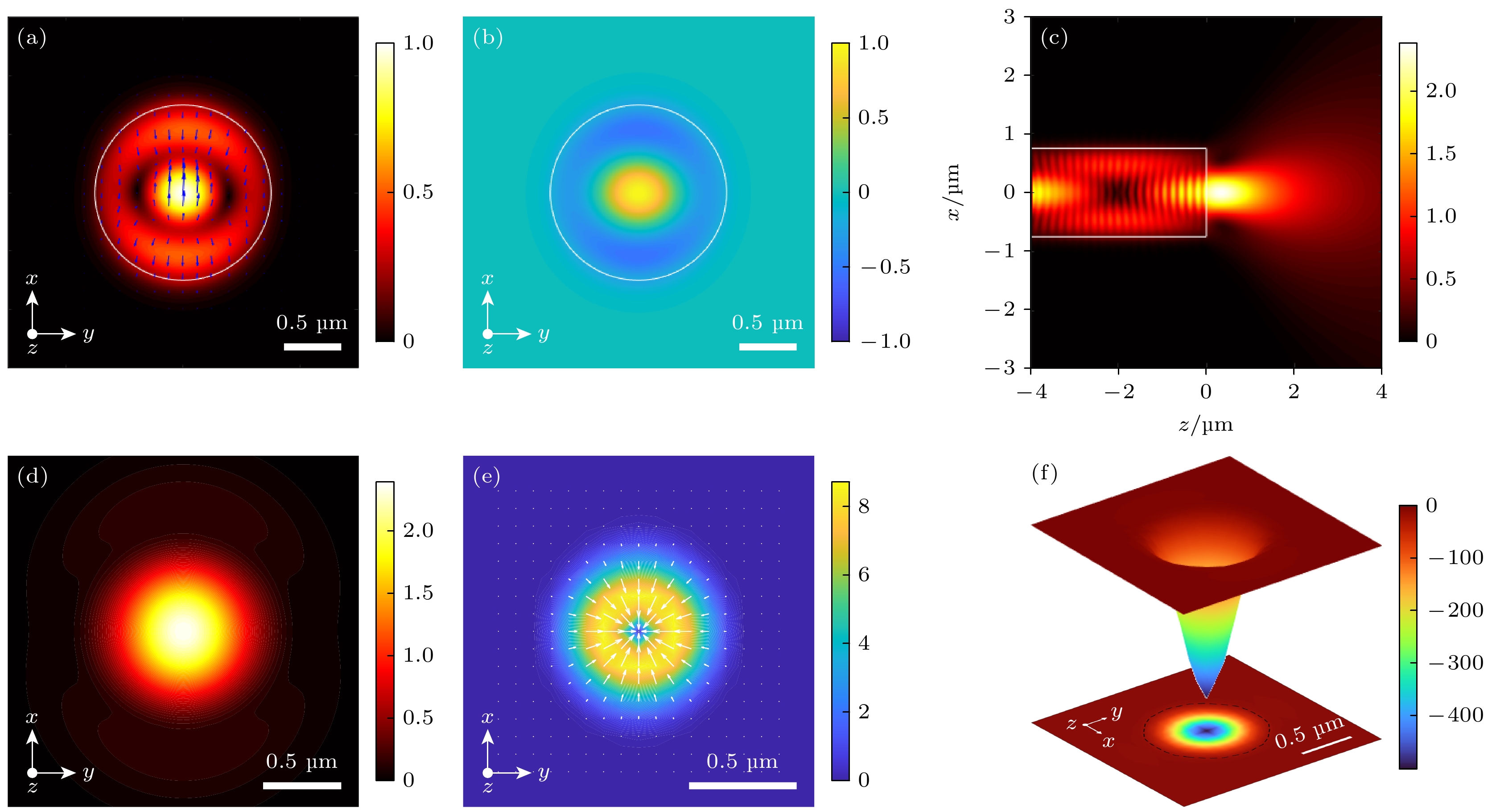-
The ability to focus light on a subwavelength scale is essential in modern photonics. Optical microfiber-based sub-wavelength focusing will allow a miniaturized, flexible and versatile tool for many applications such as biomedical imaging and optomechanics. For a separate mode exited from an optical micro-/nanofiber endface, the photons will experience significant diffraction into the free space. This situation can be changed by incorporating two-mode interference along with the specific spatial distributions of both E -field amplitude and phase. Herein we report a novel approach to realizing sub-wavelength focusing based on the two-mode interference exited from an optical microfiber endface. By utilizing specific distributions of E -field amplitude and phase of two interacting optical modes, interference field patterns with a single focus (e.g., via a two-mode set of HE11 and HE12) or multiple foci (e.g., via a two-mode set of HE11 and HE31) can be obtained. Then, it is proved that the constructed foci will readily facilitate and selective trapping of nanoparticles. Circular polarization of optical mode is utilized in order to bring in angular symmetry of sub-wavelength focusing patterns compared with linear polarized optical modes. Our simulation results show that the smallest focal spot produced from the EH11 and HE12 mode interference has a full width at half-maximum (FWHM) of ~ 348 nm (i.e. 0.65λ). Such a subwavelength focusing field is applied to the optical trapping of an 85 nm-diameter polystyrene nanosphere. Further calculation reveals that the stable trapping can be fulfilled with axial and transverse trap stiffness of 11.48 pN/(μm·W) and 64.98 pN/(μm·W), as well as axial and transverse potential well of 101 kBT/W and 641 kBT/W via two-mode interference of HE11 and HE12. These values demonstrate the great improvement over conventional tapered fibers. Further investigations show that different foci, via a two-mode set of HE11 and HE31, exhibit unlike trap stiffness and potential wells, justifying the potential for nanoparticle size sorting. Based on the flexible all-fiber device, this subwavelength focusing strategy by two-mode interference may find promising applications in optical manipulation, superresolution optical imaging, data storage and nanolithography.
-
Keywords:
- two-mode interference /
- sub-wavelength focusing /
- optical microfiber
[1] Lin Z Y, Liu K, Cao T, Hong M H 2023 OEA 6 230029
 Google Scholar
Google Scholar
[2] Stoian R, Colombier J P 2020 Nanophotonics 9 4665
 Google Scholar
Google Scholar
[3] Li X P, Cao Y Y, Tian N, Fu L, Gu M 2015 Optica 2 567
 Google Scholar
Google Scholar
[4] Lindfors K, Kalkbrenner T, Stoller P, Sandoghdar V 2004 Phys. Rev. Lett. 93 037401
 Google Scholar
Google Scholar
[5] Yang H, Trouillon R, Huszka G, Gijs M A M 2016 Nano Lett. 16 4862
 Google Scholar
Google Scholar
[6] Berthelot J, Aćimović S S, Juan M L, Kreuzer M P, Renger J, Quidant R 2014 Nat. Nanotechnol. 9 295
 Google Scholar
Google Scholar
[7] Li Y C, Liu X S, Li B J 2019 Light Sci. Appl. 8 61
 Google Scholar
Google Scholar
[8] 芮光浩, 詹其文 2022 光子学报 51 0551301
 Google Scholar
Google Scholar
Rui G H, Zhan Q W 2022 Acta Photon. Sin. 51 0551301
 Google Scholar
Google Scholar
[9] Pendry J B 2000 Phys. Rev. Lett. 85 3966
 Google Scholar
Google Scholar
[10] Liu Z W, Durant S, Lee H, Pikus Y, Fang N, Xiong Y, Sun C, Zhang X 2007 Nano Lett. 7 403
 Google Scholar
Google Scholar
[11] Lee S Y, Kim K, Kim S J, Park H, Kim K Y, Lee B 2015 Optica 2 6
 Google Scholar
Google Scholar
[12] Genet C, Ebbesen T W 2007 Nature 445 39
 Google Scholar
Google Scholar
[13] Khorasaninejad M, Zhu A Y, Roques-Carmes C, Chen W T, Oh J, Mishra I, Devlin R C, Capasso F 2016 Nano Lett. 16 7229
 Google Scholar
Google Scholar
[14] Garcı́a-Vidal F J, Martı́n-Moreno L, Lezec H J, Ebbesen T W 2003 Appl. Phys. Lett. 83 4500
 Google Scholar
Google Scholar
[15] 虞华康, 刘伯东, 吴婉玲, 李志远 2019 68 149101
 Google Scholar
Google Scholar
Yu H K, Liu B D, Wu W L, Li Z Y 2019 Acta Phys. Sin. 68 149101
 Google Scholar
Google Scholar
[16] 张毅, 傅涵堉, 梁洁, 朱嘉, 周林 2022 光子学报 51 0551309
 Google Scholar
Google Scholar
Zhang Y, Fu H Y, Liang J, Zhu J, Zhou L 2022 Acta Photon. Sin. 51 0551309
 Google Scholar
Google Scholar
[17] Huang F M, Zheludev N, Chen Y, Javier Garcia de Abajo F 2007 Appl. Phys. Lett. 90 091119
 Google Scholar
Google Scholar
[18] Wei P K, Chang W L, Lee K L, Lin E H 2009 Opt. Lett. 34 1867
 Google Scholar
Google Scholar
[19] Wang T T, Wang X, Kuang C F, Hao X, Liu X 2010 Appl. Phys. Lett. 97 231105
 Google Scholar
Google Scholar
[20] Wang X, Fu J, Liu X, Tong L M 2009 J. Opt. Soc. Am. A 26 1827
 Google Scholar
Google Scholar
[21] Liberale C, Minzioni P, Bragheri F, De Angelis F, Di Fabrizio E, Cristiani I 2007 Nat. Photonics 1 723
 Google Scholar
Google Scholar
[22] Zhang Y, Liu Z H, Yang J, Yuan L B 2012 Opt. Commun. 285 4068
 Google Scholar
Google Scholar
[23] Fu J, Dong H T, Fang W 2010 Appl. Phys. Lett. 97 41114
 Google Scholar
Google Scholar
[24] Gong Y, Ye A Y, Wu Y, Rao Y J, Yao Y, Xiao S 2013 Opt. Express 21 16181
 Google Scholar
Google Scholar
[25] Zhang Y X, Zhou Y, Tang X Y, Wang Z, Zhang Y, Liu Z H, Zhang J Z, Yang J, Yuan L B 2021 Opt. Lett. 46 3017
 Google Scholar
Google Scholar
[26] Li Y C, Xin H B, Liu X, Zhang Y, Lei H X, Li B J 2016 ACS Nano 10 5800
 Google Scholar
Google Scholar
[27] Li Y C, Xin H B, Lei H X, Liu L L, Li Y Z, Zhang Y, Li B J 2016 Light Sci. Appl. 5 e16176
 Google Scholar
Google Scholar
[28] Rogers E T F, Savo S, Lindberg J, Roy T, Dennis M R, Zheludev N I 2013 Appl. Phys. Lett. 102 31108
 Google Scholar
Google Scholar
[29] Huang H, Li Q, Fu J, Wu J, Lin F, Wu X K 2015 Nanoscale 7 16504
 Google Scholar
Google Scholar
[30] Yuan G H, Rogers E T, Zheludev N I 2017 Light Sci. Appl. 6 e17036
 Google Scholar
Google Scholar
[31] Yu H K, Fang W, Gu F X, Qiu M, Yang Z Y, Tong L M 2011 Phys. Rev. A 83 053830
 Google Scholar
Google Scholar
[32] Wang S S, Fu J, Qiu M, Huang K J, Ma Z, Tong L M 2008 Opt. Express 16 8887
 Google Scholar
Google Scholar
[33] Mansuripur M, Zakharian A R 2009 Phys. Rev. A 80 023823
 Google Scholar
Google Scholar
[34] Girard C, Dereux A, Martin O J F 1994 Phys. Rev. B 49 13872
 Google Scholar
Google Scholar
[35] Tong L M, Lou J, Mazur E 2004 Opt. Express 12 1025
 Google Scholar
Google Scholar
[36] Tang X Y, Zhang Y, Su W J, Zhang Y X, Liu Z H, Yang X H, Zhang J Z, Yang J, Yuan L B 2019 Opt. Lett. 44 5165
 Google Scholar
Google Scholar
[37] Plidschun M, Ren H, Kim J, Förster R, Maier S A, Schmidt M A 2021 Light Sci. Appl. 10 57
 Google Scholar
Google Scholar
[38] Pradhan P, Sengupta D, Wang L, Tremblay C, LaRochelle S, Ung B 2017 Sci. Rep. 7 1552
 Google Scholar
Google Scholar
[39] Zhang W D, Wei K Y, Huang L G, Mao D, Jiang B Q, Gao F, Zhang G Q, Mei T, Zhao J L 2016 Opt. Express 24 19278
 Google Scholar
Google Scholar
[40] Ismaeel R, Lee T, Oduro B, Jung Y, Brambilla G 2014 Opt. Express 22 11610
 Google Scholar
Google Scholar
[41] 肖亚玲, 刘艳格, 王志, 刘晓颀, 罗明明 2015 64 204207
 Google Scholar
Google Scholar
Xiao Y L, Liu Y G, Wang Z, Liu X Q, Luo M M 2015 Acta Phys. Sin. 64 204207
 Google Scholar
Google Scholar
[42] Zhang Y, Lin B, Tjin S C, Zhang H, Wang G H, Shum P, Zhang X L 2010 Opt. Express 18 26345
 Google Scholar
Google Scholar
[43] Liu Y X, Meng C, Zhang A P, Xiao Y, Yu H K, Tong L M 2011 Opt. Lett. 36 3115
 Google Scholar
Google Scholar
-
图 2 直径为1.5 μm的SiO2微纳光纤中的导模 (a)—(c)电场强度的模值(|E|), 箭头表示偏振方向; (d)—(f)电场强度主要分量的实部(Re(Ex)); (a), (d)准x线偏振HE11模; (b), (e) EH11偶模; (c), (f) HE31偶模. 电场强度的单位为V/m; 图中白色圆圈代表微纳光纤的边界, 比例尺为1 μm
Figure 2. Mode profiles of guided modes in a silica microfiber with a diameter of 1.5 μm: (a)–(c) Electric field |E|, blue arrows represent polarization directions; (d)–(f) phase distributions Re(Ex); (a), (d) x-HE11; (b), (e) even-EH11; (c), (f) even-HE31 modes. The unit of |E| is V/m, the white circles indicate microfiber walls, the scale bars are 1 μm.
图 3 模式组HE11 + EH11的聚焦光场及其对直径85 nm的PS颗粒的捕获强度 (a) xz平面; (b) yz平面; (c) 焦平面上的电场强度的模值分布(|E|), 单位为V/m; (d) 捕获平面上的势能密度分布(三维图, 单位为kBT/W)和横向光力分布(底部的二维图, 单位为pN/W). 图(c), (d)中比例尺为0.5 μm
Figure 3. E-field and trapping strength for 85 nm polystyrene (PS) particle under the two-mode set of x-HE11 and even-EH11: (a) Electric fields (|E|) in xz plane, (b) the central cross-section in yz plane; (c) the focal plane, the unit is V/m; (d) potential energy densities (3D profile) in trapping planes, with a unit of kBT/W, and the images below show the transverse force exerted on the nanoparticle in trapping planes, with a unit of pN/W: the color scale indicates the magnitude of the force and the arrows indicate its direction. Scale bars in panels (c) and (d) are 0.5 μm.
图 4 模式组HE11 + EH11在不同相对轴向相位差下的聚焦光场和颗粒捕获强度 (a) 聚焦光场的最大场强和焦深; (b) 聚焦光场的半高宽尺寸; (c) 相位差为–140°时颗粒沿光纤轴移动时的纵向光力和光捕获势能; (d) 相位差为–90°时颗粒沿光纤轴移动时的纵向光力和光捕获势能
Figure 4. Optical trapping effect of two-mode HE11 + EH11 under various phase differences: (a) Maximum E-field and working distance of the focusing light field; (b) the half width dimension of the focused light field; (c) the optical force and potential energy when particles move along the fiber axis with a phase difference of –140°; (d) the optical force and potential energy of particles moving along the fiber axis with a phase difference of –90°.
图 5 模式组HE11 + HE31的聚焦光场及其对直径85 nm的PS颗粒的捕获强度 (a) xz平面, (b) yz平面, (c) 焦平面上的电场强度的模值分布(|E|), 单位为V/m; (d) 捕获平面上的势能密度分布(三维图, 单位为kBT/W)和横向光力分布(底部的二维图, 单位为pN/W). 图(c), (d)中比例尺为0.5 μm
Figure 5. E-field and trapping strength for 85 nm polystyrene (PS) particle under the two-mode set of x-HE11 and even-HE31: (a) Electric fields (|E|) in xz plane; (b) electric fields (|E|) in yz plane; (c) electric fields (|E|) in the focal plane, the unit is V/m; (d) potential energy densities (3D profile) in trapping planes, with a unit of kBT/W, and the images below show the transverse force exerted on the nanoparticle in trapping planes, with a unit of pN/W, the color scale indicates the magnitude of the force and the arrows indicate its direction. The scale bars in panels (c), (d) are 0.5 μm.
图 6 模式组EH11 + HE31的聚焦光场及其对直径85 nm的PS颗粒的捕获强度 (a) xz平面; (b) yz平面; (c)焦平面上的电场强度的模值分布(|E|), 单位为V/m; (d) 捕获平面上的势能密度分布(三维图, 单位为kBT/W)和横向光力分布(底部的二维图, 单位为pN/W). 图(c), (d)中比例尺为0.5 μm
Figure 6. E-field and trapping strength for 85 nm polystyrene (PS) particle under the two-mode set of x-EH11 and even-HE31: (a) Electric fields (|E|) in xz plane; (b) electric fields (|E|) in yz plane; (c) electric fields (|E|) in the focal plane, the unit is V/m; (d) potential energy densities (3D profile) in trapping planes, with a unit of kBT/W, the images below show the transverse force exerted on the nanoparticle in trapping planes ,with a unit of pN/W, the color scale indicates the magnitude of the force and the arrows indicate its direction. Scale bars in panels (c) and (d) are 0.5 μm.
图 7 模式组HE11 + HE12的聚焦光场及其对直径85 nm的PS颗粒的捕获强度 (a) 准x线偏振HE12模的电场强度的模值分布(|E|), 单位为V/m, 图中箭头表示电场的偏振方向; (b) 准x线偏振HE12模的电场强度主要分量的实部(Re(Ex)); (c) xz平面聚焦光场的电场强度的模值分布; (d) 焦平面上聚焦光场的电场强度的模值分布; (e) 纳米颗粒在捕获平面上的横向光力, 单位为pN/W; (f) 纳米颗粒在捕获平面上的势能密度分布, 单位为kBT/W. 图中比例尺为0.5 μm
Figure 7. Sub-wavelength focusing based on two-mode interference of x-polarized HE11 and HE12 and potential energy (a unit of kBT/W) for an 85 nm PS particle: (a) E-field (i.e., |E|) distributions of x-HE12 mode, the unit is V/m; (b) Re(Ex) distributions of x-HE12 mode; (c) simulated interference field in the central cross-section xz plane; (d) electric fields (|E|) in the focal plane; (e) transverse force (a unit of pN/W) and (f) potential energy (a unit of kBT/W). The scale bars are 0.5 μm.
图 8 圆偏振模式组HE11 + EH11的聚焦光场及其对直径85 nm的PS颗粒的捕获强度 (a)聚焦光场在xz平面的电场强度的模值分布(|E |); (b) 焦平面上的电场强度的模值分布(|E |), 单位为V/m; (c) 纳米颗粒在捕获平面上的横向光力, 单位为pN/W; (d) 纳米颗粒在捕获平面上的势能密度分布, 单位为kBT/W. 图中比例尺为0.5
Figure 8. Trapping strength of the sub-wavelength focusing under circularly polarized mode group HE11 + EH11 and capture intensity of PS particles with a diameter of 85 nm: (a) E-field distribution of the focused light field in the xz plane; (b) electric fields (|E |) in the focal plane, the unit is V/m; (c) transverse force distributions in the trapping plane (with a unit of pN/W); (d) the trapping potential (3D profile and 2D projection) in the trapping plane, with a unit of kBT/W. The scale bars are 0.5 μm.
表 1 基于微纳光纤双模式干涉的聚焦光场
Table 1. Sub-wavelength focusing of light by the two-mode interference from an optical microfiber.
模式组合 模式1的分布特点 模式2的分布特点 聚焦光斑的分布特点 |E| Re(Ex) |E| Re(Ex) |E| 最小半高宽 工作距离/μm HE11+EH11 类高斯 类高斯 类8字型圆环 略相连的四瓣区域 椭圆形 0.83λ 0.38 HE11+HE31 类高斯 类高斯 空心圆环 独立的四瓣区域 双焦点 0.97λ 0.67 EH11+HE31 单一圆环 略相连的四瓣区域 空心圆环 独立的四瓣区域 四焦点 0.78λ 0.10 HE11+HE12 类高斯 类高斯 同心双环 同心双环 类高斯 1.21λ 0.35 EH11+ HE12 单一圆环 略相连的四瓣区域 同心双环 同心双环 三明治形 0.65λ 0.3 圆偏振态 HE11+EH11 — — — — 类高斯 1.77λ 0.40 表 2 基于微纳光纤双模式干涉的聚焦光场在光捕获方面的应用a)b)
Table 2. Optical traps created by sub-wavelength focusing fields based on two-mode interference from an optical microfiber a)b)
模式组合 颗粒横向位置(x, y)/μm 平衡位置/μm Ux/y/(kBT·W–1) Uz/(kBT·W–1) κx/y/(pN·μm–1·W–1) κz/(pN·μm–1·W–1) HE11+EH11 (0, 0) 0.58 159 80 2.22/24.66 3.57 HE11+HE31 (±0.41, 0) 0.77 99 25 11.53 4.0 EH11+HE31 (0, ±0.5) 0.34 179 26 14.64 1.34 HE11+HE12 (0, 0) 0.43 641 101 64.98 11.48 EH11+ HE12 (0, 0) 0.30 288 38 88.07 10.11 圆偏振态 HE11+EH11 (0, 0) 0.43 185 79 17.6 4.1 a) 捕获颗粒为PS小球, 直径85 nm;
b) Ux/y和Uz分别为横向和纵向的势阱深度; κx/y和κz分别为横向和纵向的捕获刚度.表 3 基于光纤的亚波长聚焦光场比较
Table 3. Comparisons of sub-wavelength focusing fields by optical fibers.
表 4 亚波长聚焦光场在光捕获应用方面的比较a)b)
Table 4. Comparisons of optical traps created by sub-wavelength focusing fields a)b).
结构 尺寸/nm Ux/y/kBT/W Uz/(kBT·W–1) κx/y/(pN·μm–1·W–1) κz/(pN·μm–1·W–1) 文献 光纤锥 85 150 70 22 4 [27] 光纤锥微透镜 85 500 240 310 60 [27] 普通单模光纤超透镜 2000 — — 90 8 [37] 普通多模光纤微透镜 200 4.6×103 6.3×103 720 250 [36] 本工作 85 641 101 64.98 11.48 — a)文献[37]捕获的颗粒为SiO2球, 其余文献的捕获颗粒为PS小球;
b) Ux/y 和 Uz 分别为横向和纵向的势阱深度; κx/y 和 κz 分别为横向和纵向的捕获刚度. -
[1] Lin Z Y, Liu K, Cao T, Hong M H 2023 OEA 6 230029
 Google Scholar
Google Scholar
[2] Stoian R, Colombier J P 2020 Nanophotonics 9 4665
 Google Scholar
Google Scholar
[3] Li X P, Cao Y Y, Tian N, Fu L, Gu M 2015 Optica 2 567
 Google Scholar
Google Scholar
[4] Lindfors K, Kalkbrenner T, Stoller P, Sandoghdar V 2004 Phys. Rev. Lett. 93 037401
 Google Scholar
Google Scholar
[5] Yang H, Trouillon R, Huszka G, Gijs M A M 2016 Nano Lett. 16 4862
 Google Scholar
Google Scholar
[6] Berthelot J, Aćimović S S, Juan M L, Kreuzer M P, Renger J, Quidant R 2014 Nat. Nanotechnol. 9 295
 Google Scholar
Google Scholar
[7] Li Y C, Liu X S, Li B J 2019 Light Sci. Appl. 8 61
 Google Scholar
Google Scholar
[8] 芮光浩, 詹其文 2022 光子学报 51 0551301
 Google Scholar
Google Scholar
Rui G H, Zhan Q W 2022 Acta Photon. Sin. 51 0551301
 Google Scholar
Google Scholar
[9] Pendry J B 2000 Phys. Rev. Lett. 85 3966
 Google Scholar
Google Scholar
[10] Liu Z W, Durant S, Lee H, Pikus Y, Fang N, Xiong Y, Sun C, Zhang X 2007 Nano Lett. 7 403
 Google Scholar
Google Scholar
[11] Lee S Y, Kim K, Kim S J, Park H, Kim K Y, Lee B 2015 Optica 2 6
 Google Scholar
Google Scholar
[12] Genet C, Ebbesen T W 2007 Nature 445 39
 Google Scholar
Google Scholar
[13] Khorasaninejad M, Zhu A Y, Roques-Carmes C, Chen W T, Oh J, Mishra I, Devlin R C, Capasso F 2016 Nano Lett. 16 7229
 Google Scholar
Google Scholar
[14] Garcı́a-Vidal F J, Martı́n-Moreno L, Lezec H J, Ebbesen T W 2003 Appl. Phys. Lett. 83 4500
 Google Scholar
Google Scholar
[15] 虞华康, 刘伯东, 吴婉玲, 李志远 2019 68 149101
 Google Scholar
Google Scholar
Yu H K, Liu B D, Wu W L, Li Z Y 2019 Acta Phys. Sin. 68 149101
 Google Scholar
Google Scholar
[16] 张毅, 傅涵堉, 梁洁, 朱嘉, 周林 2022 光子学报 51 0551309
 Google Scholar
Google Scholar
Zhang Y, Fu H Y, Liang J, Zhu J, Zhou L 2022 Acta Photon. Sin. 51 0551309
 Google Scholar
Google Scholar
[17] Huang F M, Zheludev N, Chen Y, Javier Garcia de Abajo F 2007 Appl. Phys. Lett. 90 091119
 Google Scholar
Google Scholar
[18] Wei P K, Chang W L, Lee K L, Lin E H 2009 Opt. Lett. 34 1867
 Google Scholar
Google Scholar
[19] Wang T T, Wang X, Kuang C F, Hao X, Liu X 2010 Appl. Phys. Lett. 97 231105
 Google Scholar
Google Scholar
[20] Wang X, Fu J, Liu X, Tong L M 2009 J. Opt. Soc. Am. A 26 1827
 Google Scholar
Google Scholar
[21] Liberale C, Minzioni P, Bragheri F, De Angelis F, Di Fabrizio E, Cristiani I 2007 Nat. Photonics 1 723
 Google Scholar
Google Scholar
[22] Zhang Y, Liu Z H, Yang J, Yuan L B 2012 Opt. Commun. 285 4068
 Google Scholar
Google Scholar
[23] Fu J, Dong H T, Fang W 2010 Appl. Phys. Lett. 97 41114
 Google Scholar
Google Scholar
[24] Gong Y, Ye A Y, Wu Y, Rao Y J, Yao Y, Xiao S 2013 Opt. Express 21 16181
 Google Scholar
Google Scholar
[25] Zhang Y X, Zhou Y, Tang X Y, Wang Z, Zhang Y, Liu Z H, Zhang J Z, Yang J, Yuan L B 2021 Opt. Lett. 46 3017
 Google Scholar
Google Scholar
[26] Li Y C, Xin H B, Liu X, Zhang Y, Lei H X, Li B J 2016 ACS Nano 10 5800
 Google Scholar
Google Scholar
[27] Li Y C, Xin H B, Lei H X, Liu L L, Li Y Z, Zhang Y, Li B J 2016 Light Sci. Appl. 5 e16176
 Google Scholar
Google Scholar
[28] Rogers E T F, Savo S, Lindberg J, Roy T, Dennis M R, Zheludev N I 2013 Appl. Phys. Lett. 102 31108
 Google Scholar
Google Scholar
[29] Huang H, Li Q, Fu J, Wu J, Lin F, Wu X K 2015 Nanoscale 7 16504
 Google Scholar
Google Scholar
[30] Yuan G H, Rogers E T, Zheludev N I 2017 Light Sci. Appl. 6 e17036
 Google Scholar
Google Scholar
[31] Yu H K, Fang W, Gu F X, Qiu M, Yang Z Y, Tong L M 2011 Phys. Rev. A 83 053830
 Google Scholar
Google Scholar
[32] Wang S S, Fu J, Qiu M, Huang K J, Ma Z, Tong L M 2008 Opt. Express 16 8887
 Google Scholar
Google Scholar
[33] Mansuripur M, Zakharian A R 2009 Phys. Rev. A 80 023823
 Google Scholar
Google Scholar
[34] Girard C, Dereux A, Martin O J F 1994 Phys. Rev. B 49 13872
 Google Scholar
Google Scholar
[35] Tong L M, Lou J, Mazur E 2004 Opt. Express 12 1025
 Google Scholar
Google Scholar
[36] Tang X Y, Zhang Y, Su W J, Zhang Y X, Liu Z H, Yang X H, Zhang J Z, Yang J, Yuan L B 2019 Opt. Lett. 44 5165
 Google Scholar
Google Scholar
[37] Plidschun M, Ren H, Kim J, Förster R, Maier S A, Schmidt M A 2021 Light Sci. Appl. 10 57
 Google Scholar
Google Scholar
[38] Pradhan P, Sengupta D, Wang L, Tremblay C, LaRochelle S, Ung B 2017 Sci. Rep. 7 1552
 Google Scholar
Google Scholar
[39] Zhang W D, Wei K Y, Huang L G, Mao D, Jiang B Q, Gao F, Zhang G Q, Mei T, Zhao J L 2016 Opt. Express 24 19278
 Google Scholar
Google Scholar
[40] Ismaeel R, Lee T, Oduro B, Jung Y, Brambilla G 2014 Opt. Express 22 11610
 Google Scholar
Google Scholar
[41] 肖亚玲, 刘艳格, 王志, 刘晓颀, 罗明明 2015 64 204207
 Google Scholar
Google Scholar
Xiao Y L, Liu Y G, Wang Z, Liu X Q, Luo M M 2015 Acta Phys. Sin. 64 204207
 Google Scholar
Google Scholar
[42] Zhang Y, Lin B, Tjin S C, Zhang H, Wang G H, Shum P, Zhang X L 2010 Opt. Express 18 26345
 Google Scholar
Google Scholar
[43] Liu Y X, Meng C, Zhang A P, Xiao Y, Yu H K, Tong L M 2011 Opt. Lett. 36 3115
 Google Scholar
Google Scholar
-
 10-20240181Suppl.pdf
10-20240181Suppl.pdf

Catalog
Metrics
- Abstract views: 4897
- PDF Downloads: 110
- Cited By: 0


















 DownLoad:
DownLoad:







